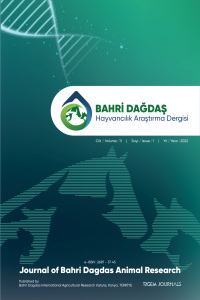Fitobiyotiklerin Metanogenezise Etkisi
Metan gazı ruminantların sindirim sisteminde meydana gelen fermentasyon sonucu ortaya çıkmakta, dışarı ruktus ile atılmaktadır. Metan gazının bu şekilde dışarı atılması ile yemle alınan brüt enerjinin % 212’si kaybedilmektedir. Atmosferdeki metan gazı miktarı son birkaç yüzyılda iki katına çıkmış olup metanın küresel ısınma potansiyeli karbondioksit gazının 21 katıdır. İklim değişikliği ve küresel ısınma konusunda en önemli çerçeve olan Kyoto Protokolü’ne göre ülkeler toplam sera gazı emisyonlarını 1990 yıllarındaki seviyelere düşürmek durumundadırlar. Türkiye, Kyoto Protokolü’nün 25. Maddesi uyarınca Katılım Belgesinin tevdii tarihini izleyen 90. gün olan 26 Ağustos 2009’dan itibaren Protokol’e taraf olmuştur. Metan üretimini azaltmaya yönelik stratejiler, metanojenlerin rumende yer alan diğer mikroorganizmalar ile ilişkisine odaklanmaktadır. Bunun için iki yol bulunmaktadır. Bunlardan birincisi doğrudan metanojenleri etkilemektir. İkinci yol ise metanogenezis için substrat kaynaklarına dolaylı etki etmektir. Bunları gerçekleştirmek için ruminatların beslenmesinde fitobiyotikler kullanılabilmektedir. Fitobiyotikler, bitkisel kökenli bileşikler olup hayvanlarda verimi arttırmaktadır. Bitkilerin yaprak, çiçek, tohum, kök, odunsu yapıları ile bu yapıların uçucu yağları ve ekstraktları fitobiyotik kavramı içerisinde yer alır. Fitobiyotiklerin metan üretimini azaltmaları antimikrobiyel aktiviteleri ve rumende hidrojen miktarını düşürmeleri ile olmaktadır. Fitobiyotiklerin içerdiği bileşiklerden saponinler protozoa, uçucu yağlar metanojenlerin miktarını, kondanse tanen ise hem protozoa hem de metanojen miktarını azaltmaktadır. Uçucu yağlar, rumen metanojen populasyonu aktivitesi üzerinden rumende yer alan metanojenlerin toplam sayısından ziyade metanojen türlerinin dağılımına etki etmektedirler. Ancak fitobiyotiklerin optimum kullanım dozu bilinmemekte olup daha çok in vivo ve uzun süre devam eden çalışmalara ihtiyaç duyulmaktadır
Anahtar Kelimeler:
Metanogenezis, fitobiyotik, metan
The Effects of Phytobiotics on Methanogenesis
Methane gas in the digestive system of ruminants in the result of the fermentation occurring is thrown out with ruktus. Methane gas feeding the disposal of the gross energy taken out so that 2-12% of these cases. The amount of methane in the atmosphere has doubled in the last few centuries out of methane is 21 times the global warming potential of carbon dioxide. The most important Kyoto framework on climate change and global warming Protocol 'according to what countries are required to reduce total greenhouse gas emissions to the levels of 1990. Turkey, the Kyoto Protocol has established in accordance with Article 25 following the date of deposit of the 90 the Participation Certificates day on 26 August 2009 from the beginning has been a party to the Protocol. Strategies to reduce methane production, located in the rumen methanogens who focuses on the relationship with other microorganisms. There are two ways to do this. The first is to directly influence methanogens. The second way is to influence indirectly the substrate source for methanogenesis. To achieve that, in the feeding of ruminants phytobiotics be used. Phytobiotics are compounds is of vegetable origin increases efficiency in animals. Plants leaves, flowers, seeds, roots, essential oils and extracts of these structures are included within the concept of the woody structure phytobiotics. To reduce the production of methane phytobiotics the antimicrobial activity of the rumen and is with reducing the amount of hydrogen. Saponins from compounds contained in phytobiotics protozoa, the amount of those essential oils methanogens while reducing the amount of condensed tannin protozoa both methanogens. Essential oils, rumen methanogens, rather than the total number of the population in the rumen methanogens located on methanogenic activity tend to influence the distribution of species. But it is is not known optimal dose of phytobiotics use are needed more in vivo and prolonged trials
Keywords:
Methanogenesis, phytobiotics, methane,
- ISSN: 2148-3213
- Yayın Aralığı: Yılda 2 Sayı
- Başlangıç: 2014
- Yayıncı: Bahri Dağdaş Uluslararası Tarımsal Araştırma Enstitüsü
Sayıdaki Diğer Makaleler
Tokat İlinin Hayvansal Atık Kaynaklı Biyogaz Enerjisi Potansiyeli ve Uygulanabilirliği
Sedat KARAMAN, Harun AVAN, Zeki GÖKALP
Türkiye’de Sığırlar İçin Gelişen Bir Tehdit: Lumpy Skin Disease
Serkan İrfan KÖSE, Alper ERTÜRK
Süt Sığırlarında Süt Kompozisyonunu Etkileyen Faktörler ve Besleme - Süt Kompozisyonu İlişkisi
Fitobiyotiklerin Metanogenezise Etkisi
Savas ATASEVER, Kursat DEMIRYUREK, Huseyin ERDEM
Studies on Caseous lymphadenitis in Chinkara Deer (Gazella bennettii), Pakistan
Syed Abdul KHALIQ, Riaz HUSSAIN, Abdul GHAFFAR, Farah ALI, Abdul QAYYUM
